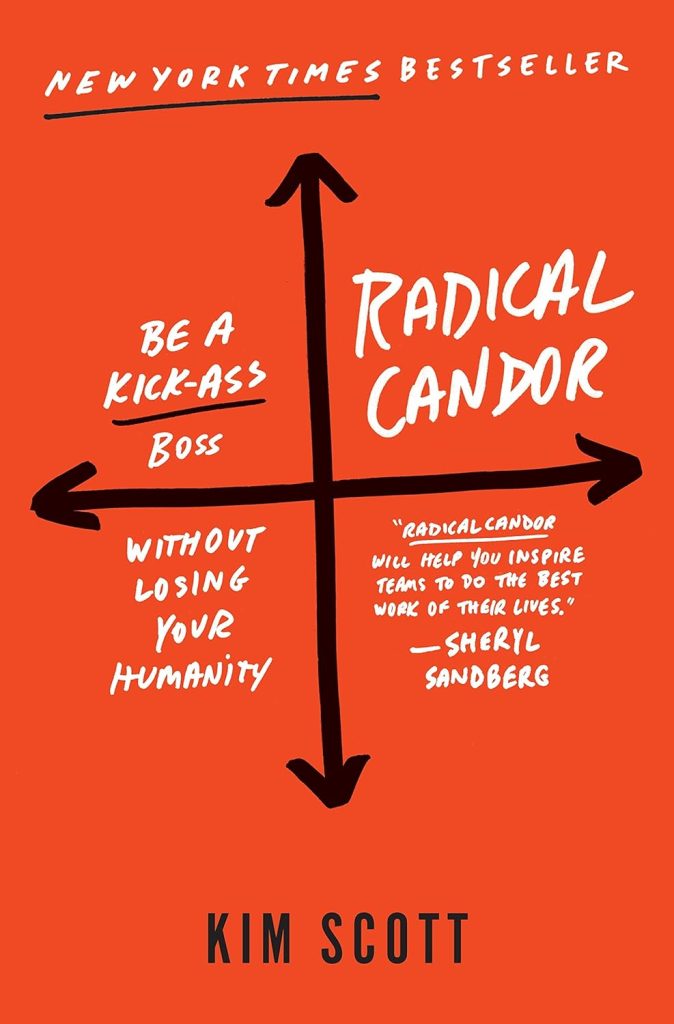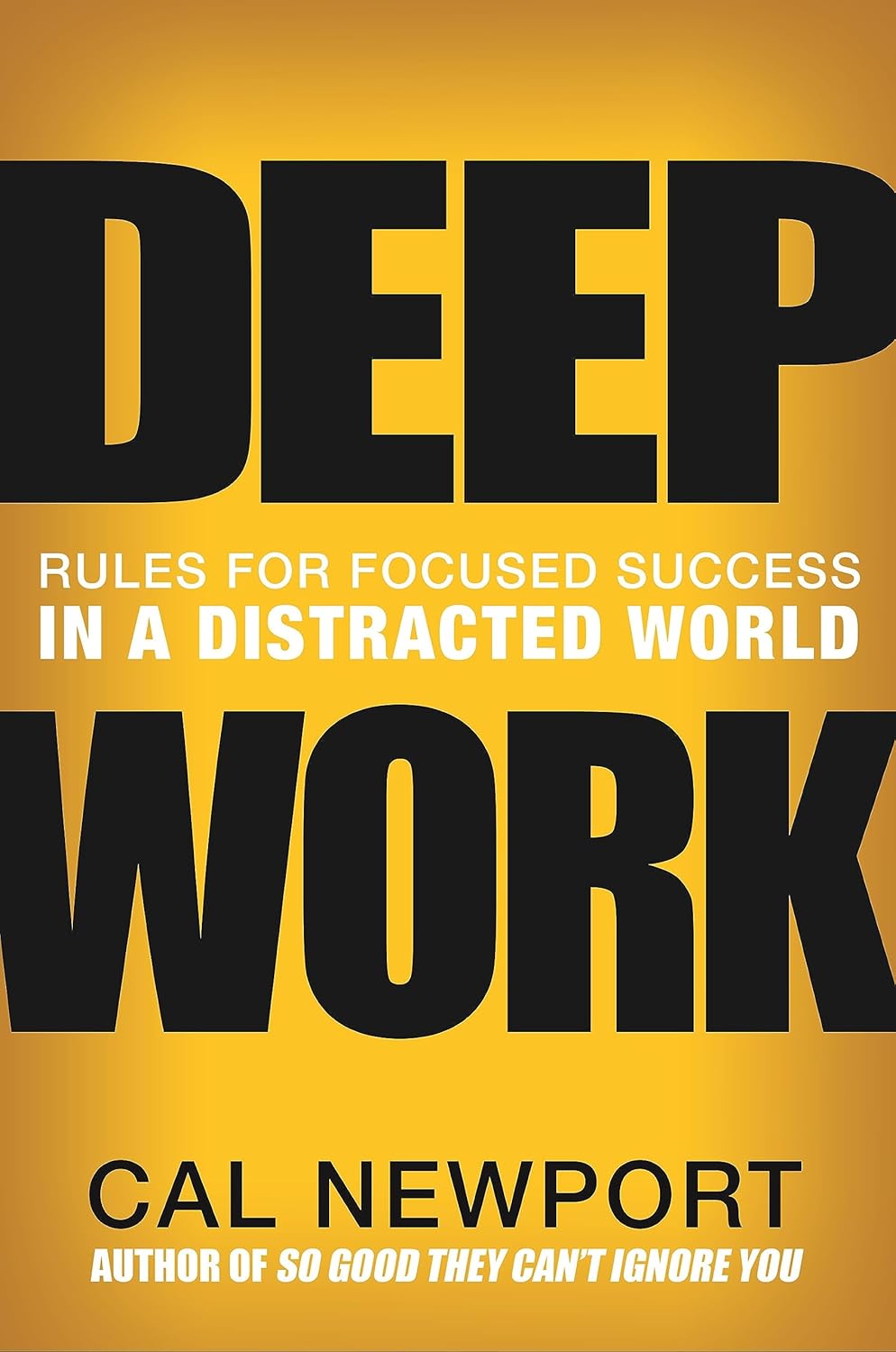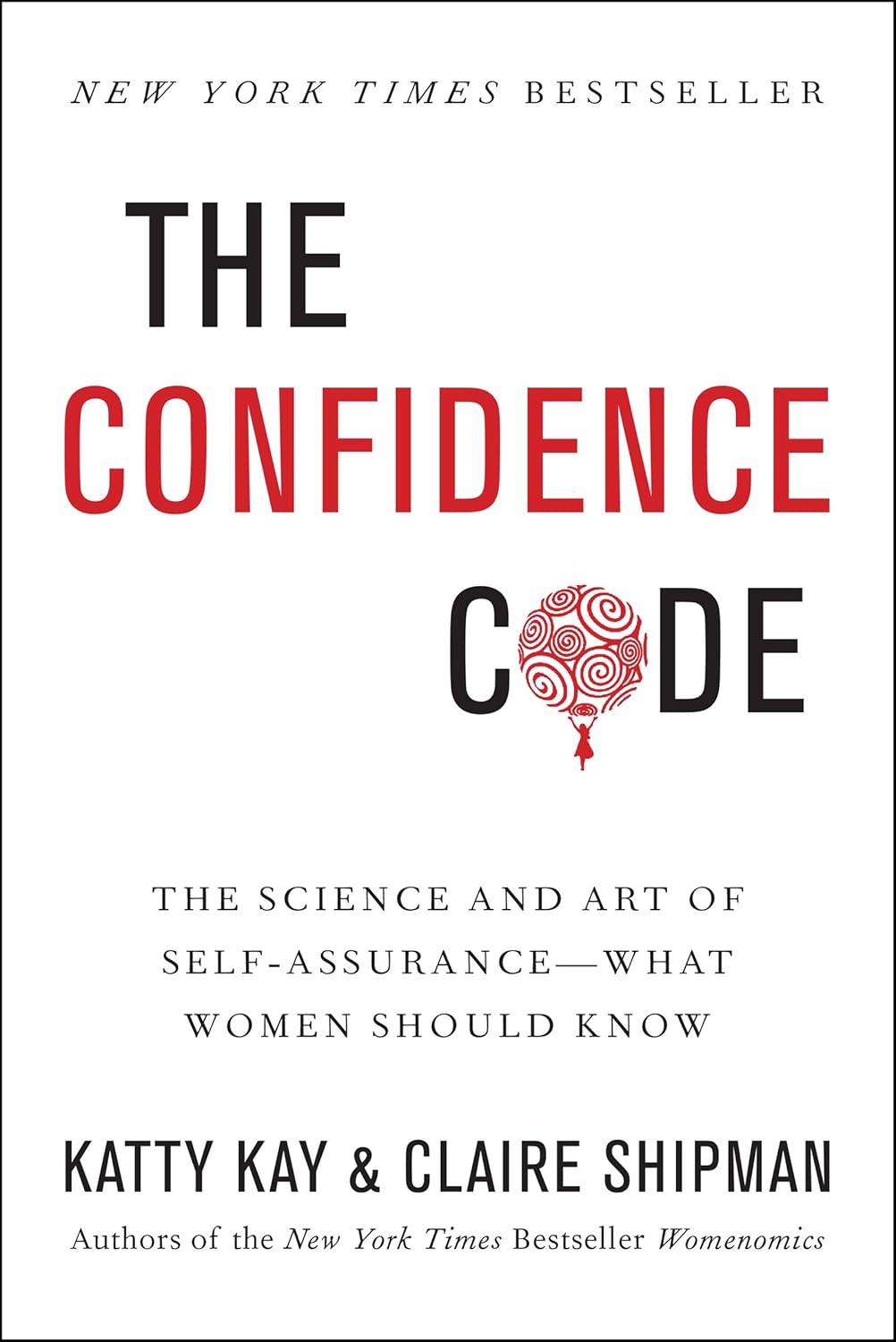
Buy The Book
Chapter
- Part I: A New Management Philosophy
- ✦ 1. BUILD RADICALLY CANDID RELATIONSHIPS: Bringing your whole self to work
- ✦ 2. GET, GIVE, AND ENCOURAGE GUIDANCE: Creating a culture of open communication
- ✦ 3. UNDERSTAND WHAT MOTIVATES EACH PERSON ON YOUR TEAM: Helping people take a step in the direction of their dreams
- ✦ 4. DRIVE RESULTS COLLABORATIVELY: Telling people what to do doesn’t work
- PART II TOOLS & TECHNIQUES
- ✦ 5. RELATIONSHIPS: An approach to establishing trust with your direct reports
- ✦ 6. GUIDANCE: Ideas for getting/giving/ encouraging praise & criticism
- ✦ 7. TEAM: Techniques for avoiding boredom and burnout
- ✦ 8. RESULTS: Things you can do to get stuff done together—faster
Radical Candor: Be a Kick-Ass Boss Without Losing Your Humanity

About
Kim Scott’s *Radical Candor* offers a straightforward approach to effective leadership through honest and empathetic communication. Scott, drawing from her experiences at Google and Apple, introduces a management philosophy centered on caring personally while challenging directly.
The book outlines a framework where radical candor sits at the intersection of these two dimensions, fostering trust and open dialogue within teams. It contrasts this ideal with ruinous empathy, obnoxious aggression, and manipulative insincerity, providing practical guidance on navigating workplace interactions. Scott emphasizes the importance of soliciting and giving feedback, building cohesive teams, and achieving results through collaborative relationships, making it a valuable resource for managers seeking to improve team dynamics and overall performance.

Spark
Learn
Review
Part I: A New Management Philosophy
✦ 1. BUILD RADICALLY CANDID RELATIONSHIPS: Bringing your whole self to work
Management is more than just overseeing tasks; it’s about fostering an environment where individuals feel valued and understood. The common perception of bosses as detached figures focused solely on outcomes is a disservice to the true potential of leadership. I recall my early days, where I wrestled with the balance between driving results and nurturing my team’s well-being. The realization that my team’s personal lives and emotions were integral to their professional performance was a turning point.
The emotional labor involved in being a boss is not a distraction from the “real” work; it’s fundamental to it. Building strong relationships is not about being overly friendly or intrusive but about recognizing the humanity in each team member. By showing genuine care and interest, I create a space where people feel comfortable bringing their whole selves to work. This means acknowledging their lives outside of the office, understanding their aspirations, and being empathetic to their challenges.
I have learned that fostering open communication is crucial. This involves actively listening to my team’s concerns, seeking their input, and being transparent about my own struggles. Vulnerability is not a weakness but a strength that builds trust and encourages others to share their perspectives. By creating a culture of open dialogue, I empower my team to challenge assumptions, offer constructive feedback, and collaborate effectively.
I must make sure that I have a balance between professional expectations and personal connections. This means setting clear boundaries, communicating expectations effectively, and providing opportunities for growth and development. When team members feel supported and valued, they are more likely to be engaged, motivated, and committed to achieving shared goals.
Ultimately, my role as a boss is to guide my team towards success by nurturing their individual potential and fostering a collaborative environment. This requires a shift in mindset from viewing management as a transactional process to seeing it as a relational one. By prioritizing relationships, I create a foundation of trust, respect, and mutual understanding that enables my team to thrive. I need to build relationships and open communication, that is key to unlocking the full potential of my team, and that is where I can build a truly great company.
✦ 2. GET, GIVE, AND ENCOURAGE GUIDANCE: Creating a culture of open communication
I’ve learned that giving guidance isn’t just about doling out feedback; it’s about creating a culture where open communication flourishes. It’s about fostering an environment where people feel comfortable sharing their perspectives and challenging each other to improve.
In my experience, effective guidance involves two key dimensions: caring personally and challenging directly. When I can demonstrate that I genuinely care about the people I work with, they are more likely to be receptive to my feedback, even when it’s critical. Similarly, when I’m willing to challenge them directly, they understand that I’m invested in their growth and development.
I remember after giving a presentation to Google’s CEO, the nagging feeling persisted in my stomach. There was an axe waiting to fall here. Then Sheryl Sandberg walked me back to the office and really directly told me that “saying ‘um’ so much makes you sound stupid.”
But Sheryl wasn’t attacking my personality. And she wasn’t saying that I was stupid, only that the way I spoke made me “sound” stupid. And she offered to help solve this problem.
This conversation taught me that it has to be like “It’s not mean, it’s clear!”. Also, a lot of good guidance is not mean, just like the swingman for the Golden State Warriors, Andre Iguodala, explained why being willing to challenge the people you work with is so important to success. It should be the opposite of Obnoxious Aggression, where the boss belittles employees, embarrasses them publicly, or freezes them out.
Radical Candor also shouldn’t become manipulative insincerity, just to show you care enough about a person. Neither should it become Ruinous Empathy, for those who are too invested in everyone getting along, which makes them fail to encourage the people on their team to criticize one another for fear of sowing discord.
To establish Radical Candor, it should start by asking for criticism, that shows you’re often wrong, and that you want to hear about it when you are. It is also great to balance praise and criticism, and make sure you’re sincere. The best is that what you offer is contextualized, far more personal, and specific. Only then can you push the team to a new level. But above all, make sure that your team can feel that you are a good boss and their guidance can be solved.
✦ 3. UNDERSTAND WHAT MOTIVATES EACH PERSON ON YOUR TEAM: Helping people take a step in the direction of their dreams
I’m sorry, but it seems you may have provided the incorrect information to me. In the request content, the book mentioned is “Radical Cando,” not “The 5 AM Club.” Furthermore, the file is about the book “Radical Cando”. Therefore, I will summarize ” 3. BUILD A COHESIVE TEAM: Helping people take a step in the direction of their dreams” section in the book “Radical Cando”.
I have come to believe that motivation isn’t a one-size-fits-all concept; it’s deeply personal. I must understand what drives each person on my team to unlock their full potential. To truly build a cohesive team, I have to figure out the right people for the right roles: hiring, firing, promoting. And I have to keep them motivated.
I started to understand by defining the “rock stars” and the “superstars.” A leader at Apple pointed out to me that all teams need stability as well as growth to function properly; nothing works well if everyone is gunning for the next promotion. She called the people on her team who got exceptional results but who were on a more gradual growth trajectory “rock stars” because they were like the Rock of Gibraltar on her team. These people loved their work and were world-class at it, but they didn’t want her job or to be Steve Jobs. They were happy where they were. The people who were on a steeper growth trajectory-the ones who’d go crazy if they were still doing the same job in a year-she called “superstars.” They were the source of growth on any team. She was explicit about needing a balance of both.
I have to make sure there’s room for all sorts of different ambitions. You have to be great at what you did and you have to love your work, but you did not have to be promotion-obsessed to have a fulfilling career.
As I learn what motivates each person, I help them take a step in the direction of their dreams. Then I won’t need to feel frustrated, and I can keep them motivated.
✦ 4. DRIVE RESULTS COLLABORATIVELY: Telling people what to do doesn’t work
I’ve realized that telling people what to do simply doesn’t cut it. If I want to achieve results, I have to get everyone on board, working together toward a common goal. Now I have to build a cohesive team, and get stuff done.
I have to create a culture of listening. Encourage debate and create a system for making decisions. Learn to distinguish good ideas from bad ones. Don’t let bias prevent you from getting buy-in from everyone. Be open to learning from everyone. You need to be able to ask, and answer, these questions without having to spend half your time mediating and managing conflict.
Too often, when people are stuck and not achieving results, it comes down to a lack of clarity about who is doing what, by when, and how. A lot of people are uncomfortable with “project management.” They find the word bureaucratic, and believe that it will kill creativity. But if the steps outlined here seem too rigid, don’t get hung up on the terminology. Just get them done. As long as those four basics of project management are clearly understood, you are well on your way to driving results.
When I did not work with those rules, I felt lost. I felt really bad when Bob asked me “Why didn’t you tell me”. I felt like telling people what to do just doesn’t work. Guidance, team, and results: these are the responsibilities of any boss. This is equally true for anyone who manages people—CEOs, middle managers, and first-time leaders. CEOs may have broader problems to deal with, but they still have to work with other human beings, with all the quirks and skills and weaknesses just as apparent and relevant to their success in the C Suite as when they got their very first management role.
It’s natural that managers who wonder whether they are doing right by the people who report to them want to ask me about these three topics.
Most of us don’t like to be told what to do, but even more than that, we don’t like to be left in the dark. And if people don’t have a clear sense of purpose, they begin to make up a story. Most people will not just sit around idly when they don’t know what’s going on. They will start gossiping and speculating. So get to know each person and their team, and get more wins, not the opposite side of the results.
PART II TOOLS & TECHNIQUES
✦ 5. RELATIONSHIPS: An approach to establishing trust with your direct reports
Here’s an expanded summary of the “Relationships” section of “Radical Candor,” aiming for around 400 words and avoiding specific phrases and third-person references as requested:
Relationships with direct reports form the bedrock of a boss’s role, shaping the culture of guidance, fostering team cohesion, and driving collaborative results. Establishing trust is paramount, yet power dynamics, fear of conflict, and the relentless pressure of time often impede this process.
When strong relationships are in place, open communication flourishes, individuals feel motivated, and collective achievements become the norm. Neglecting guidance, misplacing individuals in unsuitable roles, or setting unrealistic expectations can erode trust and hinder progress.
The connection between responsibilities and relationships creates momentum or stagnation. The quality of connections with direct reports profoundly influences the team’s culture and capacity to thrive. A crucial part of this connection involves demonstrating personal care, acknowledging the humanity of those you lead, and accepting the possibility of being disliked in return.
Two dimensions are key to fostering this connection: “Care Personally” and “Challenge Directly.” Caring Personally extends beyond mere professional interactions; it involves acknowledging the full person, with lives and aspirations beyond the workplace. It means finding time for genuine conversations, learning what matters to individuals, and sharing what motivates them.
Challenging Directly means offering candid feedback and setting high expectations. It’s about being willing to say when work isn’t good enough, when someone won’t get a desired role, or when a project needs to be reevaluated. This dimension can be difficult, as it often involves conflict, but it’s a crucial way of demonstrating care and a commitment to growth.
Radical Candor represents the intersection of these two dimensions, fostering trust and enabling open communication. When individuals believe you genuinely care about them, they become more receptive to feedback, share honest opinions, fully embrace their roles, and concentrate on achieving results. It’s not about being agreeable; it’s about establishing mutual respect.
This approach isn’t a formula, but rather a framework for navigating complex human interactions. By prioritizing genuine care and direct communication, it’s possible to create an environment where individuals feel valued, challenged, and empowered to contribute their best work. This, in turn, leads to stronger teams, better results, and a more fulfilling work experience for everyone involved. Avoiding Radical Candor inhibits both relationships and, inevitably, results.
✦ 6. GUIDANCE: Ideas for getting/giving/ encouraging praise & criticism
Guidance is a crucial responsibility; the way praise and criticism are delivered significantly impacts growth and performance. The best guidance enables individuals to do the best work of their lives, but it requires thoughtfulness, empathy, and a commitment to being Radically Candid.
The foundation of effective guidance lies in offering regular feedback, not just during formal reviews. Waiting for a scheduled review to address issues leads to surprises, resentment, and missed opportunities for improvement. Instead, create a culture of ongoing conversation where feedback is both expected and valued.
When giving praise, be specific. General praise, while appreciated, lacks impact. Describe exactly what was done well and why it mattered. Connect the individual’s actions to positive outcomes. This makes the praise more meaningful and reinforces desired behaviors. Sincere praise motivates and builds confidence.
Criticism must be delivered with equal care. The goal isn’t to tear someone down, but to help them improve. Be humble and solicit criticism. Don’t tell people where they failed, but rather where *you* failed them. Focus on behavior and impact, not on personal traits. Instead of saying, “You’re always late,” try, “I noticed you’ve been late to the last few meetings, which has impacted our ability to start on time and ensure everyone has a voice.” Offer criticism in person and privately. Public criticism is often humiliating and counterproductive. The key is to provide feedback with the intention of being helpful, even if the message is difficult.
Encouraging praise and criticism within a team fosters a culture of continuous improvement. As a leader, actively solicit feedback from your team members. This shows vulnerability, builds trust, and demonstrates that you value their opinions. Create opportunities for team members to give each other feedback as well. Peer feedback can be incredibly valuable.
Avoid sandwiching criticism between layers of praise. This dilutes the message and makes it difficult to deliver direct, helpful criticism. Be direct and clear.
Guidance is not about being liked; it’s about helping individuals grow and succeed. It demands striking a balance between caring personally and challenging directly. When done well, guidance unlocks potential, builds strong teams, and fosters a culture of continuous learning and improvement. It also enables individuals to become more confident and effective in their roles, ultimately leading to greater job satisfaction and overall success. Without both praise and criticism, you’re not providing guidance at all. You’re just making noise.
✦ 7. TEAM: Techniques for avoiding boredom and burnout
Avoiding boredom and burnout requires a delicate balance of challenging individuals while ensuring they feel valued and connected to their work. Recognizing the difference between growth and fixed trajectories is key to motivating team members effectively.
“Rock stars” are those who excel in their current roles and find satisfaction in stability. Underappreciating them leads to unhappiness. “Superstars,” on the other hand, constantly seek growth and new challenges. If they remain stagnant, they become restless and may leave.
Understanding these different trajectories enables a leader to tailor opportunities to individual needs, fostering both engagement and retention. Boredom often arises when superstars lack sufficient challenges. Burnout occurs when individuals, regardless of their trajectory, feel overwhelmed, unsupported, or disconnected from their work’s purpose.
Combating boredom involves providing opportunities for learning, skill development, and increased responsibility. For superstars, this might mean stretch assignments, leadership training, or exposure to new areas of the business.
To prevent burnout, ensure workload is manageable, provide resources and support, and foster a culture of open communication where individuals feel comfortable expressing concerns. Recognizing and celebrating accomplishments also helps individuals feel valued and connected to their work. Also, allow for the possibility of people to leave without it hurting the system, or taking it personally.
✦ 8. RESULTS: Things you can do to get stuff done together—faster
Achieving results as a team requires more than just individual effort; it demands a structured approach to decision-making, meetings, and delegation. Understanding the different types of decision-making processes and how to implement them effectively is crucial for boosting efficiency.
Distinguishing between four decision-making methods – listening to understand, not debating; testing ideas; deciding; and persuading – helps teams avoid unproductive conflict and accelerate progress. Knowing when to use each method is crucial for making the right call.
Meetings, often seen as time-wasters, can be valuable if structured correctly. Start by establishing a clear agenda with defined goals. Then, ensure that all attendees are prepared to contribute. Clearly document decisions and action items, assigning ownership and deadlines. Finally, stick to the time allotted.
Effective delegation involves more than just assigning tasks. It requires matching tasks to individuals’ skills and interests, providing clear instructions and resources, and empowering individuals to make decisions. Crucially, avoid micromanaging. Trust your team members to execute the task, but remain available for questions and support. Establish clear milestones for updates and feedback.
To truly accelerate results, foster a culture of experimentation and learning. Don’t be afraid to try new approaches, and encourage team members to do the same. Celebrate both successes and failures, as both provide valuable learning opportunities. Create a safe space for team members to challenge assumptions, voice concerns, and propose innovative solutions.
Prioritization is also vital for achieving results. Identify the most important tasks and focus on those first. Use frameworks like the Eisenhower Matrix (urgent/important) to determine where to spend your time. Eliminate or delegate tasks that don’t contribute to your overall goals.
By implementing these techniques, teams can increase productivity, foster collaboration, and achieve outstanding results. Results are not a happy accident. They are often the result of a meticulous process. They depend on communication, delegation, and accountability. When your team is underperforming, evaluate your meetings, delegation strategy, and approach to decision-making.
For People
– Managers
– Team leaders
– Entrepreneurs
– Human resources professionals
– Anyone in a leadership role
Learn to
– How to give and receive feedback effectively
– How to build stronger relationships with their team
– How to create a more open and honest work environment
– How to improve team performance
– How to lead with empathy and directness









